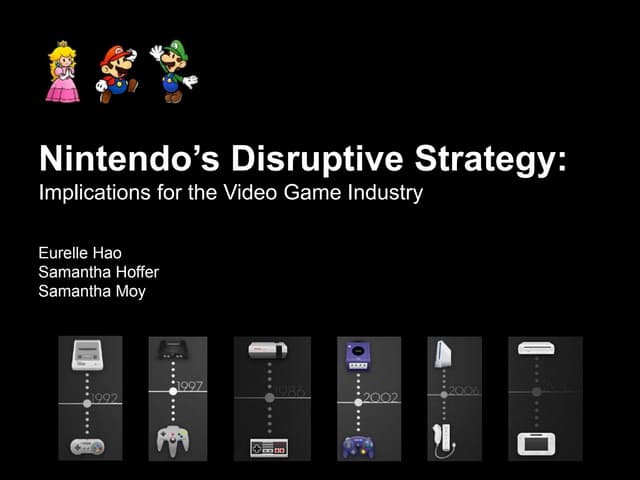Exploring Nintendo's Risk-Averse Strategy In A Changing Market

Table of Contents
Nintendo's History of Calculated Risks and Rewards
Nintendo's history isn't defined by reckless gambles, but rather by carefully calculated risks that often yielded extraordinary rewards. This measured approach to innovation has been a defining characteristic of the company's success.
Early Success with Innovative Consoles: The Game Boy, released in 1989, revolutionized portable gaming with its simple yet effective design and a killer app, Tetris. This was a calculated risk that paid off massively, establishing Nintendo as a dominant force in the handheld market. Similarly, the Wii, launched in 2006, disrupted the console landscape with its motion controls, attracting a broader audience than ever before and establishing a new “blue ocean” strategy.
- Game Boy Innovations: Durable design, affordability, long battery life, and the killer app Tetris.
- Game Boy Market Success: Global sales exceeding 118 million units, establishing Nintendo as a handheld gaming giant.
- Wii Innovations: Motion controls, intuitive gameplay, accessible price point, broadening the gaming market to include casual players.
- Wii Market Success: Over 101 million units sold, demonstrating the success of a unique gameplay approach.
Cautious Approach to Technological Advancements: Conversely, Nintendo has often been slower than its competitors to adopt new technologies. Their cautious approach to online gaming and virtual reality (VR) is a prime example. While competitors like Sony and Microsoft embraced online functionalities and VR technology early on, Nintendo maintained a more conservative stance, focusing on its core strengths.
- Delayed Online Integration: Nintendo's online infrastructure lagged behind competitors for years, impacting social gaming features.
- Limited VR Exploration: While exploring VR possibilities, Nintendo hasn't fully committed to the technology, unlike others who've heavily invested in VR headsets and games.
- Potential Drawbacks: Slower adoption can mean missing out on market trends and potentially alienating tech-savvy gamers.
The Impact of Mobile Gaming and the Rise of Subscription Services
The rise of mobile gaming and subscription services presents significant challenges to Nintendo's traditional business model.
Nintendo's Mobile Strategy and its Limited Success: Nintendo's foray into mobile gaming with titles like Pokémon GO and Mario Kart Tour has been a mixed bag. While Pokémon GO achieved phenomenal success, generating substantial revenue, the overall impact of mobile games on Nintendo's bottom line remains relatively small compared to console sales.
- Pokémon GO Revenue: A massive success, showcasing the potential of mobile gaming for Nintendo IPs.
- Mario Kart Tour Revenue: While popular, it hasn’t matched the success of Pokémon GO, highlighting the challenges of translating console experiences to mobile.
- Mobile vs. Console Revenue: Console sales still vastly outweigh mobile game revenue, indicating a continued reliance on core hardware.
The Nintendo Switch Online Service and its Competitive Landscape: Nintendo Switch Online, while offering access to classic games, lags behind subscription services like PlayStation Plus and Xbox Game Pass in terms of features, game library, and overall value proposition. Nintendo's reluctance to adopt a more comprehensive, aggressive subscription model poses a challenge in the increasingly competitive market.
- Features Comparison: Nintendo Switch Online offers a smaller library of classic games and lacks features like cloud saves compared to its competitors.
- Pricing Comparison: While more affordable than some competitors, the value proposition could be enhanced with a broader game selection and more advanced features.
- Subscription Model: Nintendo's relatively limited approach to subscription services may hinder their ability to compete effectively in a market increasingly dominated by this business model.
Maintaining Brand Identity vs. Market Adaptation
Nintendo's success is deeply rooted in its iconic first-party IPs and unique brand identity. However, maintaining this identity while adapting to a changing market requires a delicate balance.
The Importance of Nintendo's First-Party IPs: Mario, Zelda, Pokémon—these franchises are more than just games; they are cultural touchstones. They represent a consistent level of quality and familiarity that fosters strong brand loyalty and ensures a dedicated fanbase.
- Brand Loyalty: Nintendo's iconic IPs foster immense brand loyalty, ensuring a substantial customer base.
- Consistent Quality: The high-quality games associated with these IPs are crucial for sustaining their market position.
- Unique Market Position: These IPs help Nintendo maintain a distinct identity and avoid direct competition in certain genres.
Balancing Nostalgia with Innovation: Nintendo faces the constant challenge of pleasing both its loyal fanbase, which often prefers familiar experiences, and attracting new gamers seeking innovative gameplay. Finding the right balance between nostalgia and innovation is crucial for long-term success.
- Successful Innovation: The Switch’s hybrid design was a successful innovation, bridging the gap between handheld and home consoles.
- Less Successful Innovation: Some attempts at new IPs or genres haven't resonated as strongly with audiences, highlighting the risks involved in moving away from core franchises.
- Preserving Brand Identity: While pushing boundaries, Nintendo must be careful not to compromise the elements of its games that its fans value most.
Conclusion
Nintendo's risk-averse strategy has undeniably been a major contributor to its historical success. However, the evolving gaming landscape demands a careful recalibration. While preserving its unique brand identity and beloved franchises is paramount, Nintendo must increasingly consider bolder strategic moves to navigate the challenges posed by mobile gaming, subscription services, and increasingly competitive rivals. Will they continue their cautious approach, or will they embrace greater risk to maintain their position at the forefront of the gaming world? What do you think the future holds for Nintendo's strategic approach in the ever-evolving gaming market?

Featured Posts
-
 Leeds United Close To Signing 31 Cap England International
May 28, 2025
Leeds United Close To Signing 31 Cap England International
May 28, 2025 -
 Prakiraan Cuaca Semarang 22 April Hujan Siang Hari Di Jawa Tengah
May 28, 2025
Prakiraan Cuaca Semarang 22 April Hujan Siang Hari Di Jawa Tengah
May 28, 2025 -
 40 Yasindaki Ronaldo Hala Zirvede
May 28, 2025
40 Yasindaki Ronaldo Hala Zirvede
May 28, 2025 -
 French Open Alcarazs Reign Vs Swiateks Uncertain Defense
May 28, 2025
French Open Alcarazs Reign Vs Swiateks Uncertain Defense
May 28, 2025 -
 Lotto Officials Confirm Winning Euro Millions Ticket Locations In Ireland
May 28, 2025
Lotto Officials Confirm Winning Euro Millions Ticket Locations In Ireland
May 28, 2025
Latest Posts
-
 From Scullys Partner To Heisenberg Bryan Cranstons Journey
May 29, 2025
From Scullys Partner To Heisenberg Bryan Cranstons Journey
May 29, 2025 -
 Breaking Bads Success Did It Start With Bryan Cranstons X Files Appearance
May 29, 2025
Breaking Bads Success Did It Start With Bryan Cranstons X Files Appearance
May 29, 2025 -
 Did Bryan Cranstons X Files Role Influence Breaking Bad
May 29, 2025
Did Bryan Cranstons X Files Role Influence Breaking Bad
May 29, 2025 -
 The Pitt Is The Stars Famous Father Helping His Career
May 29, 2025
The Pitt Is The Stars Famous Father Helping His Career
May 29, 2025 -
 Following In Dads Footsteps The Pitts Star And His Hollywood Legacy
May 29, 2025
Following In Dads Footsteps The Pitts Star And His Hollywood Legacy
May 29, 2025
